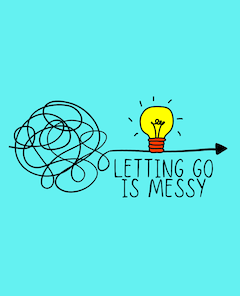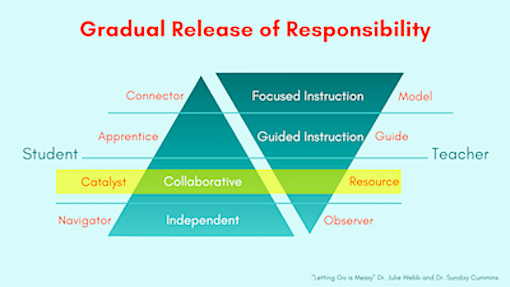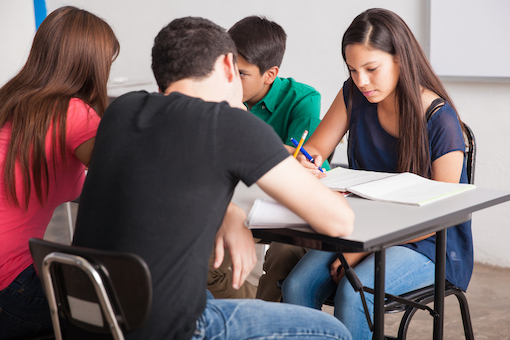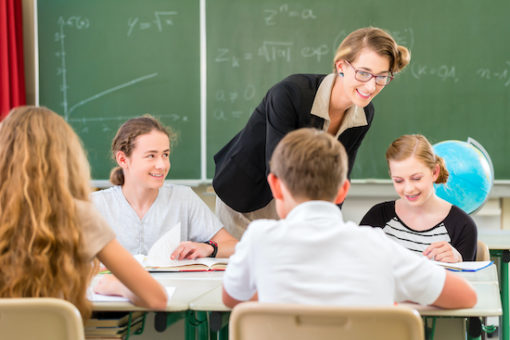GRR: When the “You Do Together” Feels Shallow
A MiddleWeb Blog
Gradual Release of Responsibility is a key classroom strategy. In a year-long series two literacy coaches, Sunday Cummins and Julie Webb, explore ways to make GRR part of everyday practice.

Working with peers, students have a chance to clarify their thinking and gain insight from each other. As a result they expand their own understanding of how to strategically process a text, and they deepen their understanding of the content in the source.
But how often does this kind of student-to-student collaboration really happen in classrooms? In our experience, what takes place more often is that students take turns (or wait for their turn) to share their own thoughts with little regard for the ideas shared by their peers.
These types of interactions masquerade as discussions but function more like one-way communication broadcasts. So what can we do to foster true collaboration during the “you do together” phase?
Keeping our roles in mind is important. During this phase of GRR, teachers are a resource, which differs somewhat from the role of model or guide. We create a safe space for students to engage in thinking about a source in a way that may be unfamiliar or difficult.
Before and during student-led conversations, we set students up to be catalysts for new thinking to occur not only for themselves but also for their peers. Our work includes observing student-led conversations and providing scaffolds that can move them forward in making meaning, both collectively and on their own. (This is different from moving them forward in getting to the answer.)
There are loads of resources on helping students engage in making meaning with each other during conversations. And chances are you have already done some work on helping students engage in this way. What follows are a few suggestions to reflect on as you think about elevating the level of meaning making that happens during the “you do together” phase of GRR.
Make sure the conversation is worth having
During reading instruction “you do together” experiences need to balance two objectives. The first is making sense of a source by strategically processing text in a way that is less familiar (e.g., coding the text to monitor for meaning making; using a purpose for reading to determine what’s important; identifying key details that support an emerging main idea). The second (and just as important) is understanding the content of that source better (e.g., developing insight into the author’s purpose; realizing there are multiple main ideas; realizing that a problem is complex).
One way we can support students to stay focused on these objectives is to make our expectations very clear. For example, in an eighth grade classroom studying the Holocaust, the teacher might post the following:
1) As a group, discuss how you would code the ideas in this excerpt. Are they familiar? Less familiar?
2) What are you learning in this excerpt that reveals the courage of this resistance group? How does this influence your understanding of the larger resistance movement?
Nurture “responding to each other” during whole group conversations. Don’t wait for students to meet in pairs or small groups before they start responding to each other.
In every conversation across the day, coach students to build on each other’s thinking. During these conversations model the kind of thinking they need to do during student-led conversations with prompts like the following:
● Who can add or build on to what Marie just said?
● Who agrees with David? What is text evidence in the source that supports what David is saying?
● What questions do you have about what Ana just said?
● Does what Javier just said resonate with you all in any way? What are you thinking in response?
This requires intentionally breaking away from typical initiate-respond-evaluate teacher to student interactions that sometimes dominate whole group or teacher-led conversations (Cazden, 2001). One way to do this is to think about your objectives for discussions which should include making sense of a source(s) but also of nurturing conversations in which students see themselves as agents of knowledge and understanding.
Offer scaffolds at the point of need
It is tempting to provide students with a list of discussion stems (e.g., “What do you mean by…?” and “Do you agree with that…?”) in a bookmark, on a placemat, or on a poster and consider that a sufficient tool for powerful conversations. While these may give some guidance on the what and how of conversations, they don’t necessarily give students the when.
As you watch students engage in conversation, think about small scaffolds you can offer to help them move forward in making meaning for themselves. In a class of sixth grade students, Sunday noticed that some students dominated the conversations, mainly sharing their thinking and not expanding on or building on others’ thinking.
During the next “you do together,” Sunday assigned those students the role of facilitator for their group. She handed each a printed question they could ask others: “What do you think about that?” and challenged them to limit their role to helping their peers build on each other’s ideas.
Sunday then coached for this when she leaned into groups. This changed the dynamic of the conversation. At least one student in each group had to really listen to their peers and think about how to help their peers connect and build on each other’s thinking.
During another lesson with a small group of fourth grade students, Sunday noticed a student made a comment that did not make sense or that revealed a misunderstanding of the content in the text, but no one asked a clarifying question.
Instead of helping the student correct their understanding, Sunday asked the group to listen to their peer again and think about whether what he said matched what they understood from the text. When they realized the discrepancy, Sunday asked, “So how can you help your friend?”
This was done within a safe space where the group had discussed how one of the purposes of “you do together” is to help each other make better sense of the content in a source. When the students decided to ask a clarifying question, Sunday offered them the language they needed, quickly writing “Can you clarify the part about…?” on a blank piece of paper for them to use at that moment.
Remove scaffolds that limit meaning making
Scaffolds should be temporary and, if left in place too long, may begin to impede authentic conversations.
For example, use of traditional Reciprocal Teaching roles like connector, summarizer, predictor, and clarifier initially supports students in developing an understanding of how they can participate in conversations (Oczkus, 2018).
Eventually, though, students should realize they can embody all of these roles during a conversation in pursuit of meaning making. Again, just as you acted as a resource in providing these roles for students, you may need to be the one who removes these scaffolds or that, as you observe groups, coaches them to let go of singular roles.
During Reciprocal Teaching groups with fifth grade students, Julie noticed how stiff students sounded when attempting to enact their assigned roles. She suspected that many of them were preoccupied by feeling anxious about leading the group, and that this preoccupation might be interfering with their purpose of making meaning together. She switched gears and asked just one student to monitor the conversation in order to allow others to focus on strategically processing the text.
At the conclusion of the discussion, the students shared that this new structure was more effective, and they agreed to take turns in the lead role going forward. Sometimes a suggested scaffold or structure doesn’t meet the needs of the unique group of students in front of you. Teachers should feel free to remove particular supports when there’s evidence that they aren’t working and when they’re no longer needed. The removal of supports is just another sign that students have grown and are ready for new challenges.
Reflect on the “why” of “You Do Together”
Help students understand the value of these conversations by setting goals before they meet. Before students begin, remind them of the potential of these conversations for helping them expand and consolidate their learning, and for leaning on their peers as resources of knowledge and partners in meaning making.
You might set specific goals like “What’s one idea someone shared that you hadn’t thought about before?” or “How did someone help you make better sense of this source?”
Then reflect on those conversations afterward. Use what you noted during the conversations to spark reflection. You might start by asking a group you observed to share how they engaged in a particular act of elaborating or clarifying together, or ask another group how they built on or challenged each others’ ideas. Support the students in explaining what they did by adding details from their conversation that you noticed during your observation.
Trust the process and your students
A common refrain we hear from teachers is “But if I leave it up to the students, they won’t know what to do.” We understand that releasing control isn’t always easy, but with practice we can learn how to make intentional shifts from phase to phase during GRR and provide and remove supports along the way. Remember, even though students are taking on more responsibility, you as the teacher still have an active role to play.
As students act as catalysts for making meaning and improving thinking, the teacher is an important resource to help foster the building of collective knowledge through productive conversations. This certainly requires that the teacher play an active role during the collaborative phase of GRR. And yes, it’s not likely that students will launch into deeply powerful discussions right away.
But that’s what makes the teacher’s role so important. Your observations and expertise are critical for supporting students as they learn these skills. And in time they will learn them, and they’ll be better readers, thinkers, and classmates as a result.
Resources
Cazden, Courtney. (2001). Classroom Discourse: The Language of Teaching and Learning (2nd ed.). Portsmouth, NH: Heinemann.
Oczkus, Lori D. (2018). Reciprocal Teaching at Work: Powerful Lessons and Strategies for Improving Reading Comprehension (3rd ed.). Alexandria, VA: ASCD.
Sunday Cummins, Ph.D, is a literacy consultant and author and has been a teacher and literacy coach in public schools. Her work focuses on supporting teachers, schools and districts as they plan and implement assessment driven instruction with complex informational sources including traditional texts, video and infographics. She is the author of several professional books, including Close Reading of Informational Sources (Guilford, 2019). Visit her website and follow her on Twitter @SundayCummins. See her previous MiddleWeb articles here.
Julie Webb, Ed.D., is a former classroom teacher and reading specialist in Title I schools who now consults with districts offering training and coaching in literacy instruction and assessment practices. Julie hosts LitCentric Radio, a literacy podcast that features powerful reading comprehension and writing lessons using children’s literature. She holds a doctorate in Educational Leadership from University of the Pacific and is a National Board Certified Teacher (Literacy). Visit her website and subscribe to her podcast. Follow her on Facebook, Instagram, and Twitter.





































